动词不定式练习题及讲解说课讲解
- 格式:doc
- 大小:52.50 KB
- 文档页数:6
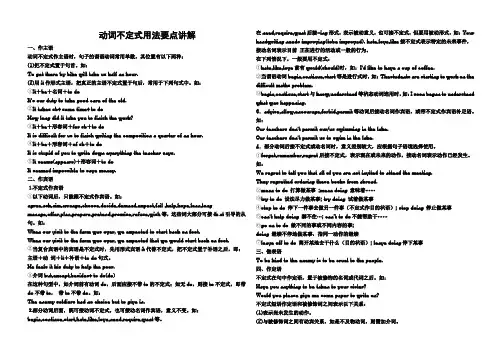
动词不定式用法要点讲解一、作主语动词不定式作主语时,句子的谓语动词常用单数,其位置有以下两种:(1)把不定式置于句首。
如:To get there by bike will take us half an hour.(2)用it作形式主语,把真正的主语不定式置于句后,常用于下列句式中。
如:①It+be+名词+to doIt's our duty to take good care of the old.②It takes sb+some time+to doHow long did it take you to finish the work?③It+be+形容词+for sb+to doIt is difficult for us to finish writing the composition a quarter of an hour.④It+be+形容词+of sb+to doIt is stupid of you to write down everything the teacher says.⑤It seems(appears)+形容词+to doIt seemed impossible to save money.二、作宾语⒈不定式作宾语①以下动词后,只能跟不定式作宾语。
如:agree,ask,aim,arrange,choose,decide,demand,expect,fail ,help,hope,lean,longmanage,offer,plan,prepare,pretend,promise,refuse,wish等,这些词大部分可接th at引导的从句。
如:When our visit to the farm was over, we expected to start back on foot.When our visit to the farm was over, we expected that we would start back on foot.②当复合宾语中的宾语是不定式时,先用形式宾语it代替不定式,把不定式置于补语之后,即:主语+动词+it+补语+to do句式。

非谓语动词(一)动词不定式一、动词不定式定义(To infinitive)动词不定式由“to + 动词原形”构成,是动词的一种非谓语的形式,即其在句中不能单独作谓语。
动词不定式具有下列属性:(1)动词不定式具有动词的性质,可以有自己的宾语和状语,也可以有时态和语态的变化;(2)动词不定式也具有非动词的性质,相当于一个名词、形容词或副词,可以在句中担任主语、宾语、宾语补足语、表语、定语和状语。
二、动词不定式(短语)的句法功能1. 作主语To say is one thing and to do is another.To know oneself is difficult.但在很多情况下,人们通常用it作为形式上的主语,而把不定式移到谓语之后,使句子结构显得平稳一些。
It is important to learn English.It seemed a pity to have wasted so much time.Activity 2: Fill in the blanks.1) __________ (see) is to believe.2) It’s difficult ________ (find) a best friend.=_____________________________________.2. 作表语不定式作表语说明主语的具体内容(目的,愿望,要求),主语通常是aim,duty,hope,idea,purpose, intention,wish等。
His wish is to become an engineer.To live is to do something worthwhile.Activity 3: Fill in the blanks.3) My wish is_________ (be) a singer.4) Your task is _________(clean) the room.3. 作宾语(1)作动词的宾语。
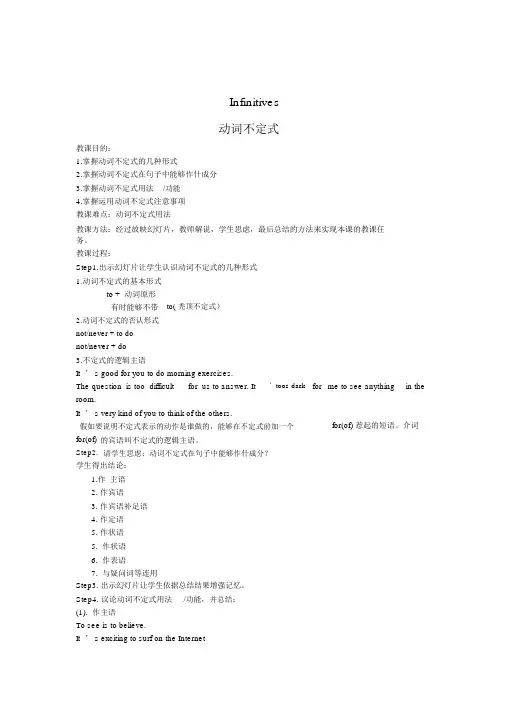
Infinitives动词不定式教课目的:1.掌握动词不定式的几种形式2.掌握动词不定式在句子中能够作什成分3.掌握动词不定式用法/功能4.掌握运用动词不定式注意事项教课难点:动词不定式用法教课方法:经过放映幻灯片,教师解说,学生思虑,最后总结的方法来实现本课的教课任务。
教课过程:Step1.出示幻灯片让学生认识动词不定式的几种形式1.动词不定式的基本形式to + 动词原形有时能够不带2.动词不定式的否认形式to( 秃顶不定式)not/never + to donot/never + do3.不定式的逻辑主语It ’ s good for you to do morning exercises.The question is too difficult for us to answer. Itroom.It ’ s very kind of you to think of the others.’toos dark for me to see anything in the 假如要说明不定式表示的动作是谁做的,能够在不定式前加一个for(of) 惹起的短语。
介词for(of) Step2.的宾语叫不定式的逻辑主语。
请学生思虑:动词不定式在句子中能够作什成分?学生得出结论:1.作主语2. 作宾语3. 作宾语补足语4. 作定语5. 作状语5.作状语6.作表语7.与疑问词等连用Step3. 出示幻灯片让学生依据总结结果增强记忆。
Step4. 议论动词不定式用法/功能,并总结:(1). 作主语To see is to believe.It ’ s exciting to surf on the Internet作主语的不定式假如很短,往常位于句首;若不定式(短语)较长时,常用 it 作形式主语,而把真实的主语(即动词不定式)放在后边以防止虎头蛇尾。
(2) 宾语I want to go home.The workers decided to get better pay.I found it necessary to talk to him again.常用动词不定式作宾语的动词有:want, hope, wish, refuse, learn,would like, choose, decide, agree,pretend, expect, planHe found it very difficult to get to sleep不定式作宾语时,如带有宾语补足语,则要把不定式放到后边,用it作形式宾语,组成“主语 +动词 +it+ 宾补(形容词、名词)+不定式”构造。
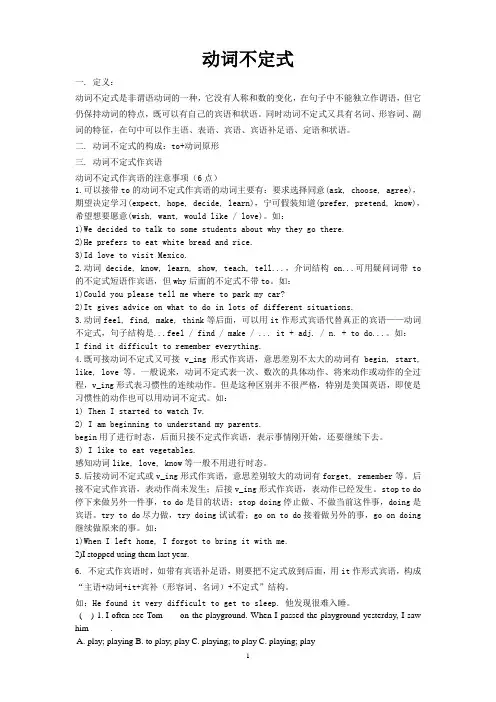
动词不定式一. 定义:动词不定式是非谓语动词的一种,它没有人称和数的变化,在句子中不能独立作谓语,但它仍保持动词的特点,既可以有自己的宾语和状语。
同时动词不定式又具有名词、形容词、副词的特征,在句中可以作主语、表语、宾语、宾语补足语、定语和状语。
二. 动词不定式的构成:to+动词原形三. 动词不定式作宾语动词不定式作宾语的注意事项(6点)1.可以接带to的动词不定式作宾语的动词主要有:要求选择同意(ask, choose, agree),期望决定学习(expect, hope, decide, learn),宁可假装知道(prefer, pretend, know),希望想要愿意(wish, want, would like / love)。
如:1)We decided to talk to some students about why they go there.2)He prefers to eat white bread and rice.3)Id love to visit Mexico.2.动词decide, know, learn, show, teach, tell...,介词结构on...可用疑问词带to 的不定式短语作宾语,但why后面的不定式不带to。
如:1)Could you please tell me where to park my car?2)It gives advice on what to do in lots of different situations.3.动词feel, find, make, think等后面,可以用it作形式宾语代替真正的宾语——动词不定式,句子结构是...feel / find / make / ... it + adj. / n. + to do...。
如:I find it difficult to remember everything.4.既可接动词不定式又可接v_ing形式作宾语,意思差别不太大的动词有begin, start, like, love等。
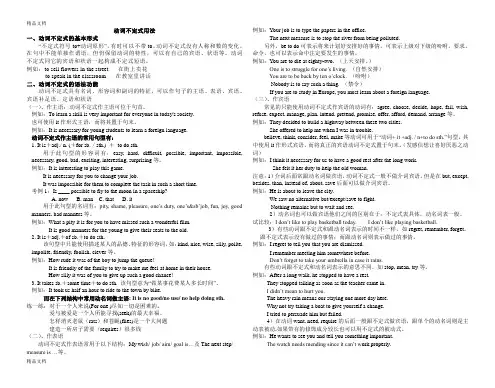
动词不定式用法一、动词不定式的基本形式“不定式符号to+动词原形”,有时可以不带to。
动词不定式没有人称和数的变化。
在句中不能单独作谓语,但仍保留动词的特性,可以有自己的宾语、状语等。
动词不定式同它的宾语和状语一起构成不定式短语。
例如:to sell flowers in the street 在街上卖花to speak in the classroom 在教室里讲话二、动词不定式的语法功能动词不定式具有名词、形容词和副词的特征,可以作句子的主语、表语、宾语、宾语补足语、定语和状语(一)、作主语:动词不定式作主语可位于句首。
例如:To learn a skill is very important for everyone in today's society.也可使用it作形式主语,而将其置于句末。
例如:It is necessary for young students to learn a foreign language.动词不定式作主语的常用句型有:1. It is+adj./ n. (+for sb./sth.) +to do sth.用于此句型的形容词有:easy, hard, difficult, possible, important, impossible, necessary, good, bad, exciting, interesting, surprising等。
例如:It is interesting to play this game.It is necessary for you to change your job.It was impossible for them to complete the task in such a short time.考例1:Is ____ possible to fly to the moon in a spaceship?A. nowB. manC. thatD. it用于此句型的名词有:pity, shame, pleasure, one’s duty, one’s&sb’job, fun, joy, good manners, bad manners等。
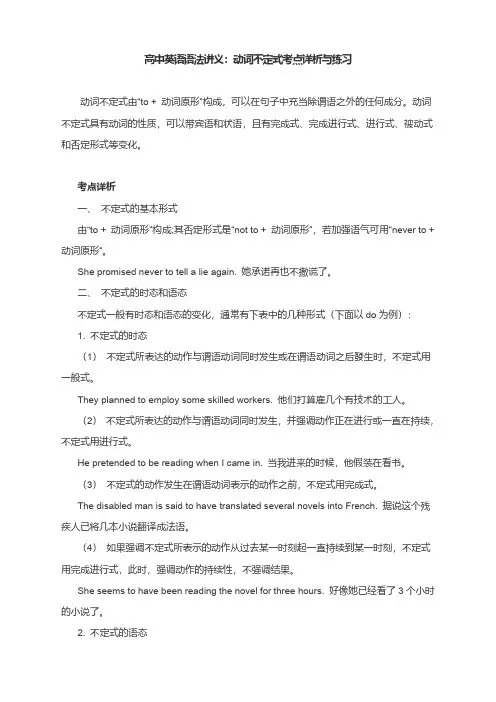
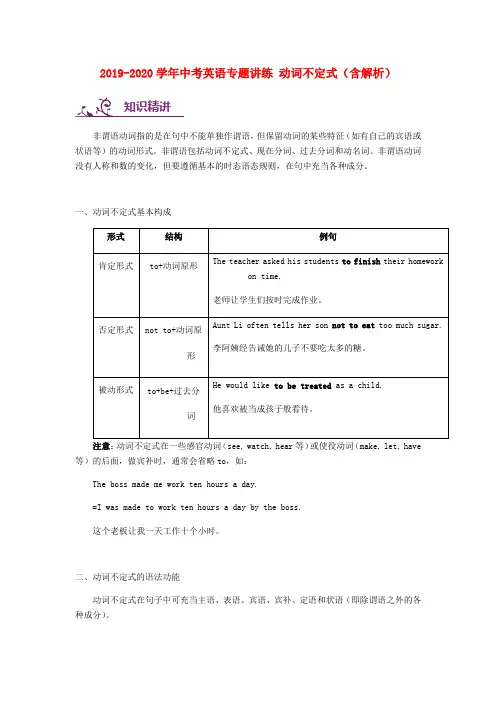
2019-2020学年中考英语专题讲练动词不定式(含解析)知识精讲非谓语动词指的是在句中不能单独作谓语,但保留动词的某些特征(如有自己的宾语或状语等)的动词形式。
非谓语包括动词不定式、现在分词、过去分词和动名词。
非谓语动词没有人称和数的变化,但要遵循基本的时态语态规则,在句中充当各种成分。
一、动词不定式基本构成注意:动词不定式在一些感官动词(see, watch, hear等)或使役动词(make, let, have 等)的后面,做宾补时,通常会省略to,如:The boss made me work ten hours a day.=I was made to work ten hours a day by the boss.这个老板让我一天工作十个小时。
二、动词不定式的语法功能动词不定式在句子中可充当主语、表语、宾语、宾补、定语和状语(即除谓语之外的各种成分)。
1. 不定式作主语1). 动词不定式短语作句子主语时,视为单数,谓语动词用第三人称单数,如:To make work more efficient is our goal.让工作更有效率是我们的目标。
2). 不定式短语作主语时,为了考虑句子的平衡,常用it作形式主语,而将真正的不定式主语放在句子后面,结构为:It+is/ was+adj. (+for sb.)+动词不定式,如上一句话也可写成:It’s our goal to make work efficient.我们的目标是让工作更有效率。
It’s very important for us to learn English well.学好英语对于我们来说很重要。
2. 动词不定式作宾语1). 动词不定式跟在及物动词后作宾语,这种形式非常常见,就是我们平时积累的一些动词后面跟to do形式,如:I have decided to study hard.我已经决定要刻苦学习。
常见的这类动词有:begin, choose, continue, decide, expect, fail, forget, hate, help, hope, learn, manage, mean, need, offer, plan, prefer, pretend, promise, refuse, try, want, wish, determine, afford, agree, start, like等。
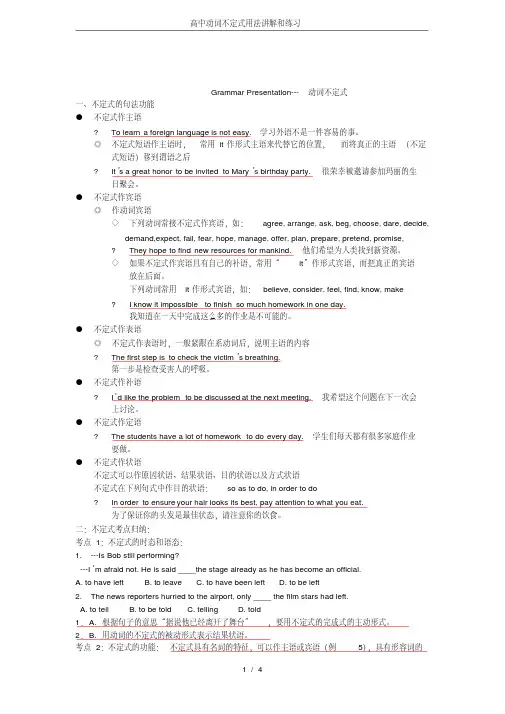
Grammar Presentation---动词不定式一、不定式的句法功能●不定式作主语?To learn a foreign language is not easy.学习外语不是一件容易的事。
◎不定式短语作主语时,常用it作形式主语来代替它的位置,而将真正的主语(不定式短语)移到谓语之后?It’s a great honor to be invited to Mary’s birthday party.很荣幸被邀请参加玛丽的生日聚会。
●不定式作宾语◎作动词宾语◇下列动词常接不定式作宾语,如:agree, arrange, ask, beg, choose, dare, decide, demand,expect, fail, fear, hope, manage, offer, plan, prepare, pretend, promise, ?They hope to find new resources for mankind.他们希望为人类找到新资源。
◇如果不定式作宾语且有自己的补语,常用“it”作形式宾语,而把真正的宾语放在后面。
下列动词常用it作形式宾语,如:believe, consider, feel, find, know, make ?I know it impossible to finish so much homework in one day.我知道在一天中完成这么多的作业是不可能的。
●不定式作表语◎不定式作表语时,一般紧跟在系动词后,说明主语的内容?The first step is to check the victim’s breathing.第一步是检查受害人的呼吸。
●不定式作补语?I’d like the problem to be discussed at the next meeting.我希望这个问题在下一次会上讨论。
●不定式作定语?The students have a lot of homework to do every day.学生们每天都有很多家庭作业要做。
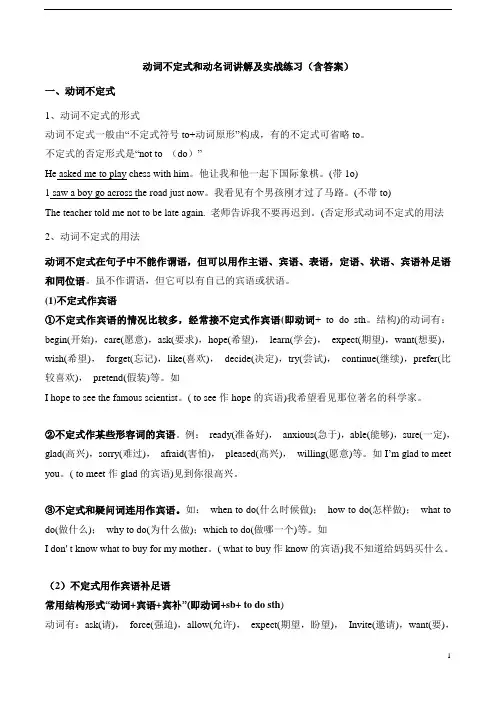
动词不定式和动名词讲解及实战练习(含答案)一、动词不定式1、动词不定式的形式动词不定式一般由“不定式符号to+动词原形”构成,有的不定式可省略to。
不定式的否定形式是“not to (do)”He asked me to play chess with him。
他让我和他一起下国际象棋。
(带1o)1 saw a boy go across the road just now。
我看见有个男孩刚才过了马路。
(不带to)The teacher told me not to be late again. 老师告诉我不要再迟到。
(否定形式动词不定式的用法2、动词不定式的用法动词不定式在句子中不能作谓语,但可以用作主语、宾语、表语,定语、状语、宾语补足语和同位语。
虽不作谓语,但它可以有自己的宾语或状语。
(1)不定式作宾语①不定式作宾语的情况比较多,经常接不定式作宾语(即动词+ to do sth。
结构)的动词有:begin(开始),care(愿意),ask(要求),hope(希望),learn(学会),expect(期望),want(想要),wish(希望),forget(忘记),like(喜欢),decide(决定),try(尝试),continue(继续),prefer(比较喜欢),pretend(假装)等。
如I hope to see the famous scientist。
( to see作hope的宾语)我希望看见那位著名的科学家。
②不定式作某些形容词的宾语。
例:ready(准备好),anxious(急于),able(能够),sure(一定),glad(高兴),sorry(难过),afraid(害怕),pleased(高兴),willing(愿意)等。
如I’m glad to meet you。
( to meet作glad的宾语)见到你很高兴。
③不定式和疑问词连用作宾语。
如:when to do(什么时候做);how to do(怎样做);what to do(做什么);why to do(为什么做);which to do(做哪一个)等。

语法:动词不定式动词不定动式是一种非谓语动词形式,它没有人称和数的转变,在句子中不能作谓语,但能够作除谓语之外的其它任何句子成份(主语、表语、宾语、宾语补足语、定语和状语);动词不定式具出名词、形容词和副词的特点,同时还维持动词的某些特点,既能够有自己的宾语和状语,动词不定式和它的宾语和状语组成不定式短语。
一、组成:to do .否定式not to do二、常见时态:一样时to do 进行时to be doing 完成式to have done完成进行式to have been doing三、动词不定式在句子中的成份一、作句子的主语:现实中常用it 作形式主语,而把真正的主语动词不定式(或短语)后置。
比较以下句子To learn from your friends is important.=It is important to learn from your friends .To leave without saying goodbye is impolite.= It is impolite to leave without saying goodbye.To chat with Miss White is a pleasant thing.=It is a pleasant thing to chat with Miss White.To walk to school takes me ten minutes.=It takes me ten minutes to walk to school.句型总结It is + adj. + of sb. to do…= sb. is\are +adj. +todo…在以某些表示人的品质、特点等的形容词(如kind、good、nice、wrong、clever、right等)作表语时,不定式之前常加一个引发的短语,说明不定式指的是谁的情形(能够明白得为某人的好,坏,伶俐,愚蠢,对,错等等)。

初中非谓语动词动词不定式讲解与练习不定式(to do )I. 不定式的意和构(初中 ):仔察下列句子,你了什么?She hopes to be a singer.Jim will teach me to play the piano tonight.They asked us to help him with his English yesterday.Teenagers have already been allowed to choose their own clothes.I was made to stay up till 11:30 last night.你注意到了?上述划部分没有受句子主的人称、复数影响而生化,都用“ to +原形”( to do )的形式,种“to +原形”(to do)就叫不定式(基本式)。
其中“ to”无意,只是不定式的志.不定式的构:1. 肯定式 : to do否定式:not to do如:He asked me not to talk about it any more.The boss made the workers not leave before 12 o ’clock at night.2. 被式 : to be done not to be doneThe floor needs to be swept at once.I expect myself not to be chosen to take part in the activity.3. 不定式的疑构(与不定式用): what /where /how / which (not) to do whether to doHe doesn’tknow what to wear and where to play . (作 )Did you tell her how to deal with her trouble? ( 作 )The question is when to start . (作表)Which kind of friends to make with is very important.(作主)How not to hurt their feelings is an important problem that we have to consider.II.不定式的作用 :不定式可以作除以外的任何句子成分, 因此叫非。
初中非谓语动词动词不定式讲解与练习动词不定式(to do)I. 动词不定式的意义和结构(初中):请仔细观察下列句子,你发现了什么?She hopes to be a singer.Jim will teach me to play the piano tonight.They ask ed us to help him with his English yesterday.Teenagers have already been allowed to choose their own clothes.I was made to stay up till 11:30 last night.你注意到了吗?上述划线部分没有受句子主语的人称、单复数影响而发生变化,都用“to + 动词原形”(to do)的形式,这种“to + 动词原形”(to do)就叫动词不定式(基本式)。
其中“to”无实际意义,只是动词不定式的标志.动词不定式的结构:1. 肯定式: to do 否定式为: not to do 如:He asked me not to talk about it any more.The boss made the workers not leave before 12 o’clock at night.2. 被动式为: to be done not to be doneThe floor needs to be swept at once. I expect myself not to be chosen to take part in the activity.3. 动词不定式的疑问结构(与动词不定式连用):what /where /how /which (not) to do whether to doHe doesn’t know what to wear and where to play. (作宾语)Did you tell her how to deal with her trouble? (作宾语)The question is when to start. (作表语)Which kind of friends to make with is very important. (作主语)How not to hurt their feelings is an important problem that we have to consider.II. 动词不定式的作用:动词不定式可以作除谓语以外的任何句子成分, 因此叫非谓语动词。
非谓语动词讲解及练习:动词不定式(The Infinitive)动词不定式(The Infinitive)动词不定式:(to)+ do,具有名词、形容词、副词的特征。
一、不定式的形式:主动被动一般式 to do to be done进行式 to be doing /完成式 to have done to have been done完成进行式 to have been doing /否定式:not /never + (to) do二、不定式的句法功能:1.作主语:eg.)To make a speech here is an honor.To lose heart means failure.动词不定式短语作主语时,常用形式主语it作形式主语,如上两句可用如下形式:It is an honor to make a speech here.It means failure to lose heart.常用结构:It+be+ adj./n.+ for sb. to do sth.It+be+ adj. + of sb. to do sth. =sb. be + adj. + to do sth.(常见形容词:clever, silly, foolish, stupid, wise, kind, rude, impolite, careless, cruel, crazy, etc.)Eg.)It’s necessary for us to have a good knowledge of English.It is foolish of you to make such a mistake.=You are foolish to make such a mistake.2.作表语:eg.)Her wish is to become a novelist.He appears to have caught a cold.不定式一般紧跟在系动词如be, seem, remain, appear等后面,用来说明主语的内容。
八年级语法知识一. 教学内容:动词不定式[学习过程]一、句子的成分及动词不定式在句子中的语法作用组成句子的各个部分叫句子成分。
句子的成分主要有主语、谓语、表语、宾语、宾语补足语、定语、状语等。
1)句子的主语是表示句子所要说明的人或事物;“是什么”或“是谁”,这是一个句子的主要部分,一般由名词、代词、数词或相当于名词的词、短语、从句等(如动词不定式和动词不定式短语、动名词等)来充当,通常位于句首。
例如:The students love their teachers very much.To build this building took them about a year.Finishing the homework on time is good for a student.2)句子的谓语用来说明主语“做什么”或“怎么样”,说明主语的动作、状态或特征。
句子的谓语一般用动词来表示。
但情态动词和助动词不能单独作谓语,它们必须和实义动词或系动词一起构成谓语。
例如:My watch works very well.I can go there with you.The teachers are having a meeting in the meeting hall now.3)句子的宾语表示动作的对象或承受者,通常由名词、代词(人称代词用宾格)或是相当于名词、代词的词、短语、从句等(如动词不定式或动词不定式短语、动名词等)来充当,一般放在及物动词的后面或介词的后面。
例如:I lost my pen yesterday.I really want to go to the park with you.She decided to buy a cup of Coke and a piece of bread.Miss Sun said that I had to hand in the copy tomorrow.有些动词后面有两个宾语,我们称这为“双宾”,这类动词主要有give, send, tell, write, post, pass, teach ,wish 等。
Grammar Presentation---动词不定式一、不定式的句法功能●不定式作主语➢To learn a foreign language is not easy.学习外语不是一件容易的事。
◎不定式短语作主语时,常用it作形式主语来代替它的位置,而将真正的主语(不定式短语)移到谓语之后➢It’s a great honor to be invited to Mary’s birthday party.很荣幸被邀请参加玛丽的生日聚会。
●不定式作宾语◎作动词宾语◇下列动词常接不定式作宾语,如:agree, arrange, ask, beg, choose, dare, decide, demand,expect, fail, fear, hope, manage, offer, plan, prepare, pretend, promise, ➢They hope to find new resources for mankind.他们希望为人类找到新资源。
◇如果不定式作宾语且有自己的补语,常用“it”作形式宾语,而把真正的宾语放在后面。
下列动词常用it作形式宾语,如:believe, consider, feel, find, know, make ➢I know it impossible to finish so much homework in one day.我知道在一天中完成这么多的作业是不可能的。
●不定式作表语◎不定式作表语时,一般紧跟在系动词后,说明主语的内容➢The first step is to check the victim’s breathing.第一步是检查受害人的呼吸。
●不定式作补语➢I’d like the problem to be discussed at the next meeting.我希望这个问题在下一次会上讨论。
●不定式作定语➢The students have a lot of homework to do every day.学生们每天都有很多家庭作业要做。
动词不定式(to do)语法讲解动词不定式是由“to+动词原形”构成 (有时可以不带to),其否定形式是“not to + 动词原形”。
它属于一种非谓语动词的形式,在句子中不能充当谓语,没有人称和数的变化,但它可以保留动词的性质,其本身可以带宾语或状语等附加成分(不定式和其附加成分称为不定式短语)。
动词不定式(短语)的句法功能非常广泛,在句中可作主语、宾语、补足语、表语、定语及状语等成分。
一、作主语(1)动词不定式作主语时,谓语动词常常用单数,例如:To do morning exercises is useful for our health. 做早操有利于我们的健康。
To sweep the floor is my duty every day. 每天打扫地板是我的责任。
把以上两句变为it作形式主语的句子:(2)如果动词不定式太长,常常用it 作形式主语,而将真正的主语——动词不定式后置,例如:To learn English well is important. 对我们来说,学好英语是重要的。
It’s important for us to learn English well.It took me half an hour to walk there.我走到那儿花了半小时的时间。
it不作形式主语:___________________________________________________________ 二、作宾语(1)能够接动词不定式作宾语的有ask, agree, beg, decide, determine,fail, hope, manage, offer, plan, prepare, pretend, promise, refuse, wish 及would like/love 等动词,但finish, enjoy, miss, appreciate, mind, advise, suggest 等动词后面通常只能接动名词(doing)作宾语,例如:I hope to visit this place again.我希望能再度访问此地。
动词不定式练习题及讲解动词不定式用法要点讲解一、作主语动词不定式作主语时,句子的谓语动词常用单数,其位置有以下两种:(1)把不定式置于句首。
如:To get there by bike will take us half an hour.(2)用it作形式主语,把真正的主语不定式置于句后,常用于下列句式中。
如:①It+be+名词+to doIt's our duty to take good care of the old.②It takes sb+some time+to doHow long did it take you to finish the work?③It+be+形容词+for sb+to doIt is difficult for us to finish writing the composition a quarter of an hour.④It+be+形容词+of sb+to doIt is stupid of you to write down everything the teacher says.⑤It seems(appears)+形容词+to doIt seemed impossible to save money.二、作宾语⒈不定式作宾语①以下动词后,只能跟不定式作宾语。
如:agree,ask,aim,arrange,choose,decide,demand,expect,fail ,help,hope,lean,long manage,offer,plan,prepare,pretend,promise,refuse,wish等,这些词大部分可接th at引导的从句。
如:When our visit to the farm was over, we expected to start back on foot. When our visit to the farm was over, we expected that we would start back on foot.②当复合宾语中的宾语是不定式时,先用形式宾语it代替不定式,把不定式置于补语之后,即:主语+动词+it+补语+to do句式。
He feels it his duty to help the poor.③介词but,except,besides+to do(do)在这种句型中,如介词前有动词do,后面应接不带to的不定式;如无do,则接to 不定式,即带do不带to,带to不带do。
如:The enemy soldiers had no choice but to give in. ⒉部分动词后面,既可接动词不定式,也可接动名词作宾语,意义不变。
如:begin,continue,start,hate,like,love,need,require,want等。
在need,require,want后接-ing形式,表示被动意义,也可接不定式,但要用被动形式,如:Your handwriting needs improving(tobe improved). hate,love,like接不定式表示特定的未来事件,接动名词表示目前正在进行的活动或一般的行为。
在下列情况下,一般要用不定式:①hate,like,love前有would(should)时,如:I'd like to have a cup of coffee.②当谓语动词begin,continue,start等是进行式时,如:Thestudents are starting to work on the difficult maths problem.③begin,continue,start与know,understand等状态动词连用时,如:I soon began to understand what was happening.3.advise,allow,encourage,forbid,permit等动词后接动名词作宾语,或带不定式作宾语补足语。
如:Our teachers don't permit our/us swimming in the lake.Our teachers don't permit us to swim in the lake.4.部分动词后接不定式或动名词时,意义差别较大,应根据句子语境选择使用。
①forget,remember,regret后接不定式,表示现在或未来的动作,接动名词表示动作已经发生。
如:We regret to tell you that all of you are not invited to attend the meeting. They regretted ordering these books from abroad.②mean to do 打算做某事 ;mean doing 意味着……③try to do 设法尽力做某事; try doing 试着做某事④stop to do 停下一件事去做另一件事(不定式作目的状语); stop doing 停止做某事⑤can't help doing 禁不住…; can’t to do不能帮助干……⑥go on to do 做不同的事或不同内容的事;doing 继续不停地做某事,指同一动作的继续⑦leave off to do 离开某地去干什么(目的状语); leave doing停下某事三、做表语To be kind to the enemy is to be cruel to the people.四、作定语不定式在句中作定语,置于被修饰的名词或代词之后。
如:Have you anything to be taken to your sister?收集于网络,如有侵权请联系管理员删除Would you please give me some paper to write on?不定式短语作定语和被修饰词之间表示以下关系:(1)表示尚未发生的动作。
(2)与被修饰词之间有动宾关系,如是不及物动词,则需加介词。
(3)与被修饰词之间有逻辑上的主位关系。
(4)不定式作定语时,一般可转换为定语从句。
五、不定式作补足语⒈作宾语补足语一些及物动词除要求按宾语外,有时还需要有宾语补足语,说明宾语的行为、状态、特征,这时意思才相对完整。
(1)常要求不定式作宾补的动词有:allow,ask,advise,beg,cause,drive(强迫),encourage,expect,forbid,force,get,would like(love,hate),order,permit,persuade,teach,tell,want,warn,wish等。
如:I expect you to understand the whole passage clearly.(2)部分动词后常接to be+形容词、名词短语等形式,有时to be可省略,如:consider,imagine,judge ,prove,suppose等。
I consider him(to be)one of the best biology teachers .但当不定式是完成式时,to不能省略,如:We consider him to have been foolish.(3)感觉动词和使役动词后用作宾补的不定式须省略to。
①I didn't hear anyone say anything about it.②They make the students do too much homework every day.这种句式在变为被动语态时,to不能省略,如第②句:The students are made to do too much homework every day.(4)部分短语动词后,常接不定式作宾补,如:The Party calls on us to increase production and practise economy.常这样用的短语动词有:ask for,care for,call on ,depend on,wait for,long for(渴望),prepare for等。
⒉作主语补足语不定式作主语补足语,和主语构成一种逻辑上的主谓关系。
如:①He was not allowed to enter the classroom for being late.②The young university student is considered to have great promise.六、不定式作状语⒈作目的状语(1) I stayed there to see what would happen.(2)有时为了强调,不定式前可加in order或so as。
如:Bob took down my telephone number so as(in order)not to forget it.有时为强调目的状语可把in order to或不定式置于句首,但so as to不能这样用。
在这种句式中不定式部分可转换为so that,in order that,成为目的状语从句,如:I stayed there so that (in order that)I could see what would happen.(3)在部分表示感情色彩的形容词、过去分词或动词之后可接不定式,如:astonished,glad,happy,laugh ,pleased, sad,smile,sorry,surprised等。
①We are glad to hear the news.②I was surprised to see that a three-year-old baby could write so well.在部分形容词后接不定式,用主动形式表示被动意义,这种句型中的主语是不定式的逻辑宾语。
如:The question raised by the student is difficult to answer.The room is really comfortable to live in.常这样用的形容词有:comfortable,easy,dangerous,difficult,expensive,fit,impossible等。
⒉作结果状语We came home after our holiday to find our garden neat and tidy.不定式作结果状语还常用在下列句式中。